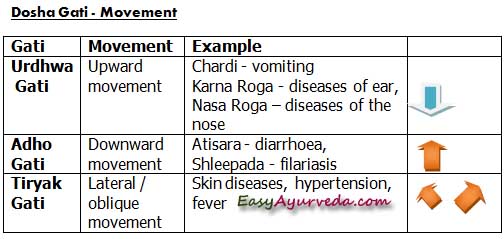Upward, Downward, Lateral Dosha Movement (Urdhwa Adho Tiryak Doshagati)
Article by Dr Raghuram Y.S. MD (Ay) & Dr Manasa, B.A.M.S
Table of Contents
Introduction
Dosha Gati is called movement of doshas. Doshas when they are in their normal state, in normal place, lead to maintenance of health. Upward, downward and lateral movement of Doshas causes diseases.
Related reading – Contributory factors for a disease
There are many types of dosha movements.
Urdhwa Gati
Urdhwa Gati of Doshas – Upward movement
When Doshas pathologically move upward, it leads to diseases of upper organs.
Diseases caused by Urdhwa Gati of doshas:
- Chardi – vomiting
- Karna Roga – diseases of ear,
- Nasa Roga – diseases of the nose,
- Kantha Roga – diseases of the throat,
- Netra Roga – diseases of the eye,
- Unmada – insanity, mania,
- Apasmara – epilepsy,
- Kasa – cough
- Hikka – hiccough,
- Shwasa – dyspnoea, breathing problems, shortness of breath, etc
Adho Gati
Adho Gati of Doshas
Downward movement of doshas leads to diseases pertaining to lower organs
- Atisara – diarrhoea,
- Shleepada – filariasis,
- Kroshtu shirshaka – swelling of knee, etc.
Tiryak Gati
Tiryak Gati of Doshas – lateral movement
Oblique movement of Doshas lead to
- Charma vyadhis – skin diseases,
- Sirapurana – Hypertension,
- Akshepaka – tetanus,
- Apatantraka – Hysteria, etc

Examples
Understanding Dosha movement with examples:
Urdhwaga Raktapitta (bleeding of pitta contaminated blood in upward direction) is an example of upward movement of Dosha. In Raktapitta –Bleeding disorders such as nasal bleeding, heavy periods, etc (bleeding disorders), along with bleeding and other symptoms are manifested in the upward direction. Contaminated blood flows through mouth, nose, ears and eyes.
Adhoga Raktapitta (bleeding of pitta contaminated blood in downward direction) is an example of downward movement of Dosha. Here, along with bleeding and other symptoms are manifested in the downward direction. Contaminated blood flows through urethra, anus and vagina.
Jwara – fever is an example for lateral movement of dosha. In this, While the fever afflicts the whole body, its symptoms, especially rise in temperature is chiefly manifested over the skin, i.e. the exterior of the body reflecting the internal pathology.
Read related: Ayurveda Lifestyle and Diet For Fever – 45 Important Things To Know
Importance
Importance of having the knowledge of upward, downward and lateral Dosha movements:
The direction of flow or movement of dosha or disease helps a physician in deciding the treatment strategy for these gatis, for the treatment would be different in each condition.
Taking the example of Raktapitta disease, it is not just bleeding which occurs in this condition, in fact it is the blood contaminated with pitta which is bleeding in different directions.
Mutual contamination of blood tissue and pitta Dosha leads to quantitative increase of contaminated blood. This contaminated and increased blood tends to overflow and bleed either from upward direction (urdhwaga raktapitta) from the nose, mouth, ears or eyes, or from downward direction (adhoga raktapitta) i.e. from anus, urethra or vagina or in sideward direction (tiryak gata raktapitta) i.e. from the hair follicles and skin.
Pratimarga Harana – Reverse root elimination
Charaka has advised Pratimarga Harana Chikitsa in the treatment of Raktapitta. Pratimarga Harana means eliminating the doshas in opposite direction of its manifestation or flow.
Example in Urdhwaga Raktapitta, the doshas are moving in the upward direction. Here kapha association is seen. Therefore the blood moves in upward direction. In this condition treatment opposite to the flow of dosha (kapha) and vyadhi (raktapitta) should be administered i.e. Virechana or purgation should be given.
Similarly in Adhoga Raktapitta bleeding occurs in downward direction. Here, raktapitta is associated with vayu and hence the movement is downwards. The treatment opposite to the route of the dosha and vyadhi should be given i.e. Vamana or purgation should be given in adhoga raktapitta.
Read related: Vitiation Of Doshas According To Movement Of Doshas In The Body
In these conditions, a physician without the knowledge of dosha gati would be tempted to give Virechana in Adhoga Raktapitta since Virechana is the best treatment for vitia ted pitta and rakta.
But Virechana would worsen the raktapitta and cause severe bleeding leading to death. The knowledge of urdhwa and adho gati of doshas would enable the physician to administer proper treatment so as to effectively treat the diseases without causing complications.
In Tiryak Gati and diseases caused by such gati like Jwara should be treated according to the treatment principles mentioned in the treatises.
Just Before Finishing –
In this article we have discussed about the directions of movement of doshas and diseases i.e. dosha gati and the importance of knowing it from the viewpoint of effective management of disorders manifesting with various gatis.
Click to Consult Dr Raghuram Y.S. MD (Ayu) – Email / Skype










2 comments
Jaideep Rana
But sir in case of adhoga-amlapitta it is advised to give virechana.
As per your article that will worsen up the situation. Please shed some light on this.
Dr J V Hebbar MD(Ayu)Author
The contra indication of virechana is only explained in adhoga raktapitta. Not in Adhoga amlapitta.